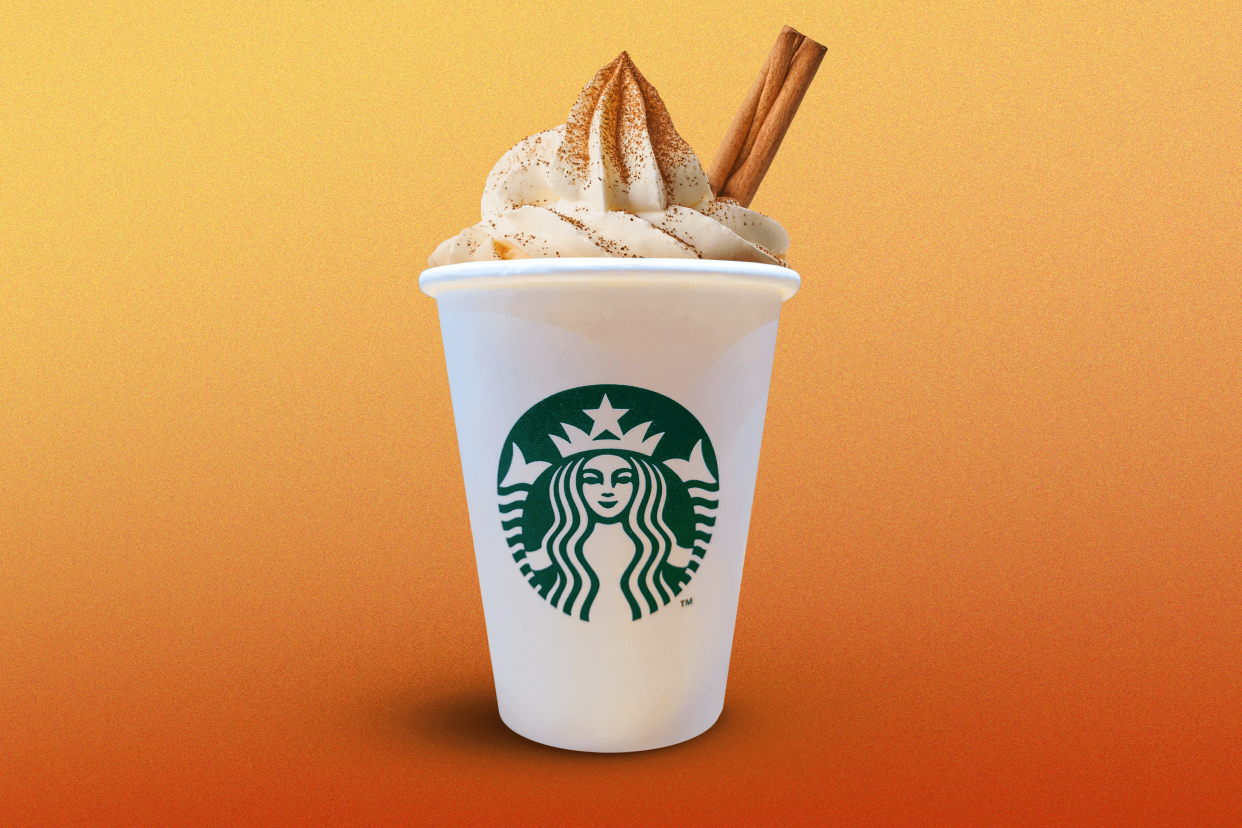Pumpkin Spice Latte season is here. Here's what dietitians say about fall's favorite drink.

Do you sense the autumn vibes in the air? Starbucks just announced that the Pumpkin Spice Latte is making its grand return on Thursday, marking what many people consider to be the unofficial beginning of fall. (For the record, actual fall doesn’t begin until the equinox on Sept. 22, a full month away.)
If you’re planning to sip this drink all season long, however, you may want to read up on the health implications of your PSL. Here’s what you need to know about this iconic coffee drink.
Why is the Pumpkin Spice Latte still a thing?
First, a history lesson: The Pumpkin Spice Latte (aka the PSL) was created by Starbucks in 2003 as a way to build on the success of their first seasonal beverage, the Peppermint Mocha. The drink — featuring a “pumpkin pie spice sauce” made with pumpkin puree and mixed in with espresso and steamed milk, then topped with whipped cream and pumpkin spices including cinnamon, clove, nutmeg and ginger — offers a taste that’s reminiscent of a pumpkin pie that felt just right for fall.
Whether you love the drink and all of its warm, cozy fall associations, or roll your eyes at the trend, the coffee beverage has cemented its place in the cultural conversation. That’s thanks in part to social media, where selfies of PSL fans clutching their seasonal sips have become an autumnal mainstay. Starbucks even gave the PSL its very own Twitter handle in 2014 as a fun way to play into the hype.
In the wake of the PSL’s popularity came an explosion of pumpkin spice everything, from Oreos to body scrub. Few offshoots, however, have enjoyed the same level of enduring success.
There’s even science to back up the passion: A 2021 study conducted by Johns Hopkins University researchers found that the spices in a PSL are associated with feelings of nostalgia. However, it may not be nostalgia alone that has people ordering the drink seasonally.
Licensed therapist David Klow, founder of Skylight Counseling Center in Chicago and author of You Are Not Crazy: Letters From Your Therapist, previously told Yahoo Life that while humans are hardwired to seek out something that’s new, we also “long to create a sense of routine in our lives.” So, when something like the PSL combines these two things by coming around just once a year, it “merges these two drives within us” — and has us zooming through the Starbucks drive-through.
But is a Pumpkin Spice Latte good for you?
So, is this fall staple a good idea to add to your diet all season long? Registered dietitian Sheri Gaw tells Yahoo Life that the spices used to give PSL its iconic flavor have a number of benefits.
“According to a 2019 review, cloves and cinnamon are excellent sources of antioxidants and with frequent consumption they are linked to a lower risk of death from cancer, respiratory disease and ischemic heart disease,” Gaw says. Plus, she notes, research shows that ginger and nutmeg are also associated with benefits, including protection against cancer, diabetes, obesity and microbial infections.
Here’s the downside: Along with all those good-for-you spices comes a lot of sugar, saturated fat and calories, says Gaw. This may contribute to a blood-sugar spike or elevated cholesterol numbers for some people.
A 16-oz Pumpkin Spice Latte (a Grande from Starbucks) has 50 grams of sugar, 390 calories and 14 grams of fat, nine grams of which are saturated. While the beverage does come with 14 grams of protein, in general, that’s more than what most of us should consume in one sweet treat — especially when there’s no fiber to speak of in a PSL.
According to the American Heart Association (AHA), women should have no more than 25 grams of added sugar per day, while men should limit their intake to 36 grams of added sugar per day. The AHA also recommends that fat should make up 25% to 35% of your daily calories, which is about 56 to 78 grams for a 2,000-calorie diet. Saturated fat should be limited to less than 7% of your daily calories, or around 13 grams per day.
It’s also important to note that, since it is an espresso-based drink, one Grande PSL clocks in at 150 mg of caffeine. This may be an issue for people who don’t tend to consume coffee during the rest of the year because they’re more likely to experience negative side effects from caffeine, such as disrupted sleep or elevated heart rate or blood pressure. More seasoned coffee drinkers should also bear in mind that, per the Food and Drug Administration, people should limit their caffeine consumption to 400 mg a day. More than two PSLs in a single day would tip you over that.
Dietitian Brittany Werner, director of coaching at Working Against Gravity, tells Yahoo Life that a PSL can fit into most nutrition plans as is, but given the low nutritional value, total calories and added sugar, “it’s clear that a PSL is genuinely a dessert.” That’s why she recommends we “treat PSLs as a special indulgence and not something that should be consumed frequently,” in order to stay on track with a healthy diet.
If you just can’t resist a PSL fix, consider asking your Starbucks barista for a substitution. “Choosing different types of milk, like skim, still offers protein and lessens the calories and fat. Then asking for half the amount of syrup, as a start, could be another way to ‘lighten’ up the drink but still provide the PSL you desire,” suggests dietitian Chris Mohr, fitness and nutrition adviser at Fortune Recommends Health.


